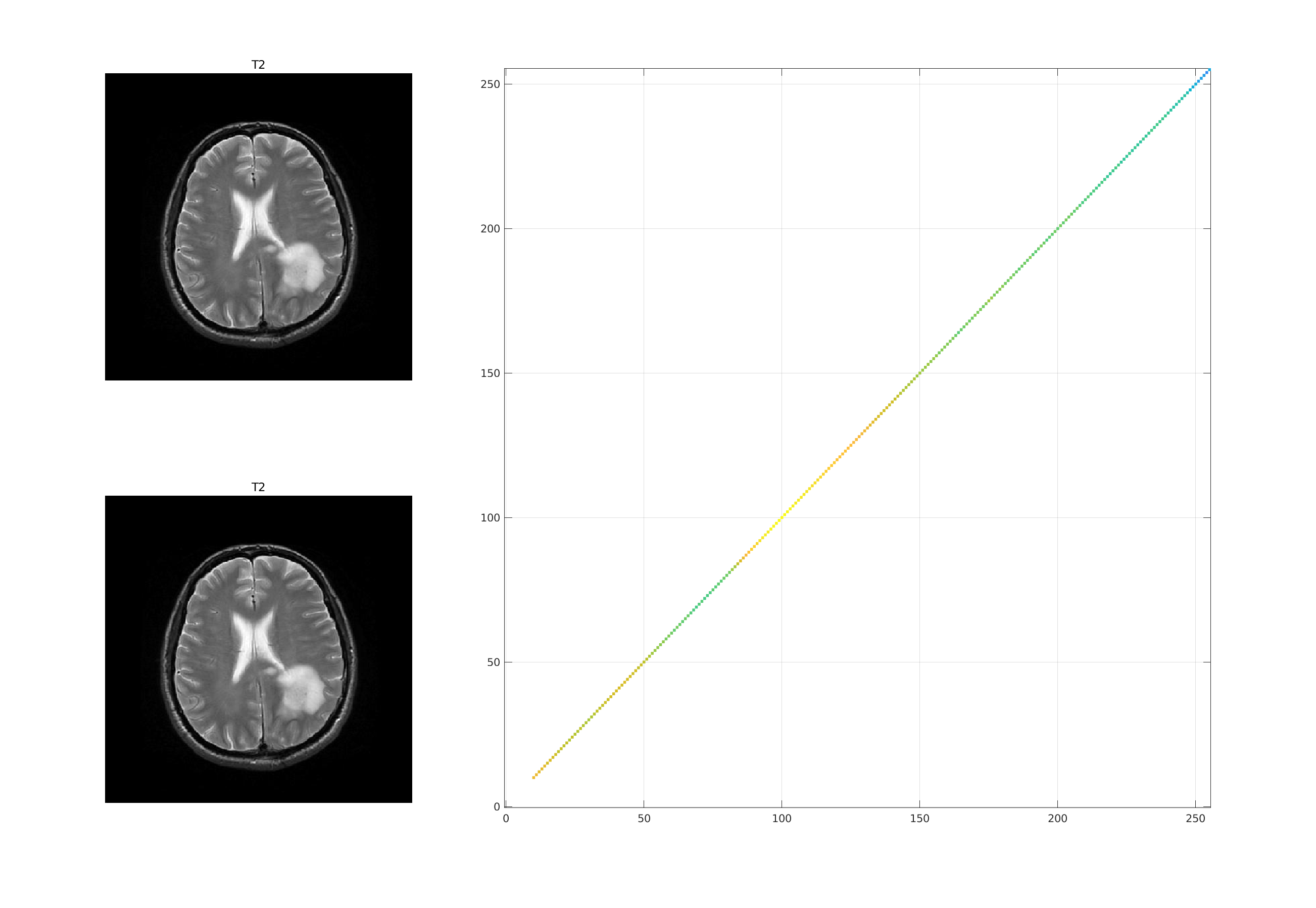Mutual Information (MI) is a commonly used similarity measure for image registration.
A pixel intensity $i_1$ in image $I_1$ is said to predict pixel
intensity $i_2$ in image $I_2$ if, when the images
overlap, pixels of intensity $i_1$ in $I_1$ usually overlap
with pixels of intensity $i_2$ in $I_2$.
The joint histogram (copied below from the last lecture),
encapsulates the idea of one pixel intensity predicting another:

Recall that $h(x,y)$ in this T1/T2 joint histogram shows the
number of times that value $x$ in the T1 image and value $y$
in the T2 image occur in the same place (i.e. overlap).
For example, if $h(x,y)$ is bright yellow (above), the
intensity $x$ in the T1 image and intensity $y$ the T2
image overlap frequently.
That means that intensity $x$ in T1 predicts intensity
$y$ in T2.
Ideally, each intensity $x$ would alway predict a unique
and different intensity $y$. Then the joint histogram
would have a single peak in each row and in each column.
For example, consider an image overlapped with a copy of
itself. Then each pixel intensity in the first image predicts
exactly one pixel intensity (the same pixel intensity)
in the other image, and the joint histogram is a set of peaks
along the diagonal, like this:

As the above images become "de-registered" by translating and
rotating one with respect to the other, the joint histogram
becomes less coherent.
Here is the joint histogram with the bottom T2 image translated
2 pixels to the right:

And with further "de-registration":

This "diminshed coherence" in the joint histogram holds true even
if the images are of different modalities, like the original T1
and T2 images:
 |
$\longrightarrow$ some translation $\longrightarrow$ |
 |
$\longrightarrow$ some translation and rotation $\longrightarrow$ |
 |
The entropy of a random variable, $X$, is a measure of the
average uncertainty in that variable: If entropy is large, we
know less about the next value of the random variable. From the
last lecture,
$H = - \sum_k P(k) \log P(k)$
Conditional entropy describes the average uncertainty in
a random variable, $X$, given knowledge of another random
variable, $Y$.
In terms of pixel intensities, $Y$ is the intensity of a pixel
in one image and $X$ is the intensity of the corresponding
(overlapped) pixel in the other image. If the images are
aligned, $Y$'s value should be a good predictor of
$X$'s value. If so, the conditional entropy of $X$, given $Y$,
should be low, since there is not much uncertainty in $X$ if we
already know $Y$, since $Y$ is a good predictor of $X$.
The conditional entropy of $X$, given $Y$, is
$H(X|Y) = \sum_y P(y) \left[ \; - \sum_x P(x|y) \log P(x|y) \; \right]$
The outer sum is the probability-weighted average value of the
thing in the square brackets, taken over all values, $y$, of $Y$.
The thing in the square brackets is the entropy of $X$, given
that we know the random variable $Y$ has value $y$. This is
just like the entropy of $X$, but takes into account the fact
that $y$ is known. Usually, the probability that $X = x$ is
denoted $P(x)$; if we know that $Y = y$, then
the conditional probability that $X = x$ is denoted
$P(x|y)$. The thing inside the square brackets is the
entropy of $\mathbf P\mathbf (\mathbf x\mathbf |\mathbf y\mathbf
)$.
So conditional entropy, $H(X|Y)$, gives a
formal measure of how well knowledge of $Y$ (the intensity of a
pixel in one image) can predict $X$ (the pixel intensity of the
overlapping pixel in the other image).
$H(X|Y)$ should be minimzed (since it's the entropy)
when $Y$ best predicts $X$. For example, if $H(X|Y) = 0$, $Y$
exactly predicts $X$.
We now have enough background to define Mutual Information ... in the next lecture.






